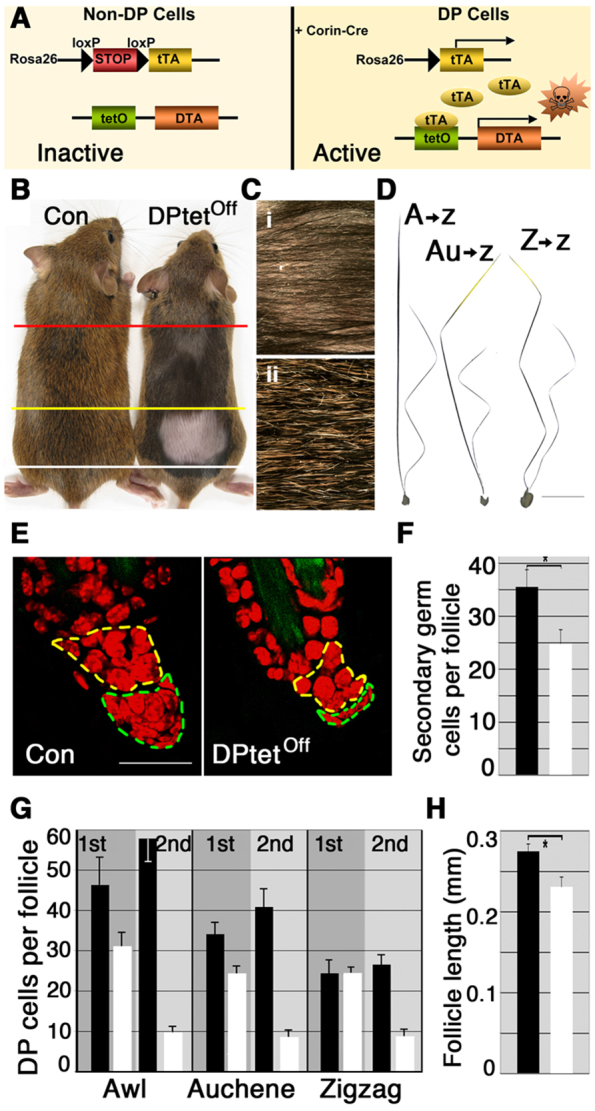Fig. 3.

DP cell depletion results in smaller hairs and failure to re-enter the anagen phase of the hair cycle. (A) All cells in DPtetOff mice start with inactive r26tTA and tetO-DTA alleles. Corin-cre expresses cre-recombinase in DP cells, which removes the stop sequence from r26tTA and leads to the production of the tet transactivator protein (tTA). This binds to the tetO sequence and initiates transcription of the DTA transgene. DTA kills the cell. (B) Control (Con) and DPtetOff are shown. Animals were shaved between the red and white lines after the first hair cycle (P21), and between the yellow and white lines after the second hair cycle (P63). Above the red line the pelage consists of the first, second and, in control, third hair coats. Between the red and yellow lines, the shorter, thinner, darker hairs produced in the second cycle by DPtetOff contrast with the normal second and third hairs of the control. Between the yellow and white lines, the lack of hair in DPtetOff reveals the failure to re-enter the anagen phase, while the control has completed the production of a third hair coat. (C) Close-up view of the thin second hair coat that does not completely cover the skin in DPtetOff (i) and corresponding region of the control (ii). (D) Dissected follicles from a DPtetOff animal reveal largely normal first hairs. However, many follicles that produced awl or auchene hairs in the first cycle produce zigzag hairs in the second cycle (A→z and Au→z, respectively), and all second cycle hairs are shorter and thinner than normal. Scale bar: 1 mm. (E) Optical sections of follicles harvested at 10 weeks of age that had produced zigzag hairs in control (Con) and DPtetOff mice. The DP is marked with a broken green line, the secondary germ region with a broken yellow line. Scale bar: 25 μm. (F) The number of cells in the secondary germ region differs significantly between control and DPtetOff follicles that produced a zigzag hair in both hair cycles (mean and s.d., n=20 follicles from two mice each,*P=1.0×10-12). (G) DP cell number per follicle in control (black bars) and DPtetOff (white bars) after the first and second hair cycles in follicles that made awl, auchene or zigzag hairs in the first hair cycle. DP cell number and hair morphology are only slightly affected after the first cycle, but dramatically reduced after the second cycle (mean and s.d., n=20/type second cycle, n=10/type first cycle). The difference between DP number in control and DPtetOff after the second cycle is significant for all three hair types shown (P<6×10-16). (H) Follicle length during second telogen, measured from the skin surface to the base of the DP differs significantly between control and DPtetOff follicles that produced a zigzag hair in both hair cycles (mean and s.d., n=44 follicles con, n=53 follicles DPtetOff from 3 mice each, * P=6.8×10-36).
